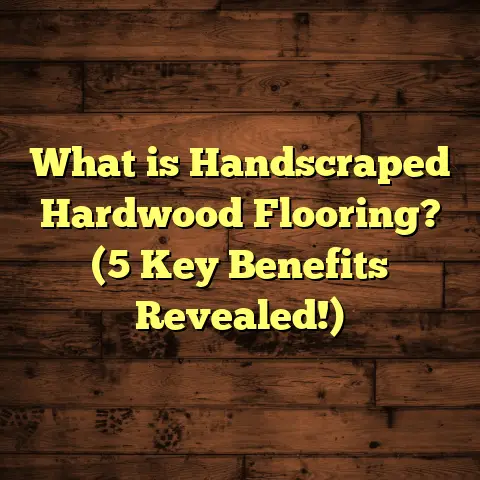What is the Average Rate for Floor Installation? (5 Key Factors Revealed)
When I think about family life, I often picture my kids running barefoot across our living room floor, laughter filling the air. The floor beneath them isn’t just a surface; it’s where they learn to walk, where we sit together for movie nights, and where memories are built over time. That’s why when it comes to installing new flooring, the decision feels deeply personal. You want something safe, durable, good-looking, and—let’s be honest—not going to drain your savings account.
So I get asked a lot: What is the average rate for floor installation? Why do prices vary so much? And how do you know if you’re getting a fair deal?
I’ve been in the flooring business for years, working with families just like yours. I’ve installed everything from budget-friendly laminates in a cozy rental to luxurious hardwood floors in large suburban homes. I’ve learned that understanding the real costs means looking beyond just the sticker price of the materials. It means knowing about labor, preparation, location, and even timing.
If you’re considering new flooring for your home, pull up a chair. I’m going to share what I’ve seen and learned about floor installation costs—and how you can get the best value for your family’s needs.
What Is the Average Rate for Floor Installation?
At its core, the average rate for floor installation is how much you pay per square foot or per project to have your floors professionally installed. This includes the cost of labor—the person or team who will lay down the flooring—as well as sometimes material delivery and preparation work like removing old floors or fixing the subfloor underneath.
But here’s the catch: “average” is a tricky word when it comes to flooring because prices vary widely based on many factors. For example:
- The type of flooring you choose (carpet, laminate, hardwood, tile, vinyl)
- The size and shape of the area being covered
- Where you live (urban vs. rural, regional labor rates)
- How much prep work is needed
- Whether old flooring needs removal
From my experience, the best way to think about average rates is by ranges rather than a single number.
Rough Average Cost Ranges Per Square Foot
Here’s a quick overview based on materials I’ve worked with extensively:
| Flooring Type | Typical Installation Cost per sq ft |
|---|---|
| Carpet | $1.50 – $4 |
| Laminate | $2 – $8 |
| Vinyl | $2 – $7 |
| Hardwood | $6 – $12 |
| Tile | $5 – $15 |
You’ll notice hardwood and tile tend to be at the higher end due to their complexity and labor intensity.
My Experience Installing Different Flooring Types
Over the years, I’ve installed various flooring types for different families, each with unique preferences and budgets. Let me share some stories showing how these choices impacted costs and satisfaction.
Laminate Flooring: Affordable and Family-Friendly
One of my early jobs was installing laminate in a young couple’s first home. They wanted something that looked like real wood but didn’t want the high cost or maintenance of hardwood.
Laminate was perfect: easy to install, affordable material and labor, and durable enough for their busy household with two dogs and a toddler. The installation cost hovered around $3.50 per square foot.
However, laminate isn’t perfect for every situation. I once installed it in a basement where moisture was high, and despite sealing precautions, some planks buckled after a couple of years. That taught me that site conditions can affect long-term results.
Hardwood Flooring: Classic Beauty at a Price
I remember working on a project where the family had just built their dream home. They chose white oak hardwood for their main living areas. The cost was around $10 per square foot for installation alone.
The process was more involved: acclimating the wood for several days so it wouldn’t warp, carefully sanding and finishing after installation for that smooth feel. It took almost double the time compared to laminate.
But the family loved how warm and timeless it looked—and they knew this floor would last decades with proper care.
Vinyl Flooring: Practical and Versatile
In kitchens and bathrooms, vinyl flooring has been my go-to recommendation many times. It’s waterproof and comes in many styles from planks that mimic wood to tiles resembling stone.
One kitchen remodel I did recently had vinyl plank installed at a total cost of roughly $7 per square foot including labor. Installation was quick and didn’t require subfloor changes.
The homeowners appreciated how easy it was to clean after spills and how comfy it felt standing there cooking dinner.
Tile Flooring: Durable but Demanding
Tile is one of my favorite materials to work with because it offers endless design options—but it can be pricey.
A bathroom renovation I completed used porcelain tiles with intricate mosaic accents around the shower. The labor took longer because cutting tiles precisely around corners was challenging.
The installation rate came out to nearly $14 per square foot due to this complexity plus grout work and sealing afterward.
The family was thrilled with the elegant look that also stood up well to moisture.
Five Key Factors That Affect Floor Installation Costs
If you want to predict what your floor installation might cost, these five factors usually give you the biggest clues:
1. Material Choice Makes a Huge Difference
As I showed earlier, material type is probably the biggest driver of cost differences. Hardwood requires more skillful labor and time than laminate or vinyl.
Besides price per square foot for materials themselves, think about durability and maintenance too.
For example:
- Carpet is often cheapest upfront but wears out faster.
- Hardwood costs more but adds resale value.
- Tile is durable but labor-intensive.
- Vinyl strikes a balance—waterproof and affordable.
When helping families choose materials, I often remind them: cheaper isn’t always better if you plan to stay in your home long term.
2. Size of Your Project Changes Pricing Dynamics
The larger your floor area, the more material needed—but interestingly, cost per square foot often drops because installers work more efficiently over bigger spaces.
Small rooms or oddly shaped areas may cost more per square foot because of extra cuts or waste.
For example, one client had a small triangular nook off their kitchen—they paid nearly double per square foot there compared to an adjacent rectangular dining room.
3. Subfloor Condition Can Add Unexpected Costs
A smooth and level subfloor is essential for any flooring type.
If your existing subfloor is damaged, uneven, or wet, contractors will have to repair or replace it before installation.
I remember one job where water damage from an old leak wasn’t visible until we removed carpet—it delayed the project by two weeks and added $1,500 in repair costs.
Getting an inspection before finalizing quotes can save surprises later.
4. Labor Rates Vary by Location
Where you live affects how much installers charge.
Urban centers tend to have higher wages and overheads than rural areas.
For instance, a hardwood installation in New York City might cost $12+ per square foot while a similar job in the Midwest could be $7-$9.
I have friends who run flooring businesses in different states—they consistently report these regional differences influence their pricing strategies heavily.
5. Removal of Old Flooring Adds Time and Expense
Don’t forget about removal costs!
Taking up old carpet or tile can add $1-$4 per square foot depending on complexity.
If your old flooring contains hazardous materials like asbestos (common in homes built before 1980), removal becomes specialized and expensive.
I always ask clients about this early on because some expect new floors without realizing removal fees can be significant.
Digging Into Data: Real-Life Cost Examples from My Projects
Numbers help paint a clearer picture. Here are detailed breakdowns from three projects I completed recently that illustrate these factors well:
Project 1: Suburban Family Living Room Hardwood
- Size: 400 sq ft
- Material: White Oak Plank Hardwood
- Labor Cost: $4,200
- Materials Cost: $2,000
- Subfloor Repair: $600
- Old Flooring Removal: $400
- Total Cost: $7,200
- Cost per sq ft: $18
This was a high-end job with premium materials and some subfloor leveling required due to settling over years. The family prioritized durability and aesthetics since they planned to stay long term.
Project 2: Urban Kitchen Vinyl Plank
- Size: 150 sq ft
- Material: Luxury Vinyl Plank
- Labor Cost: $700
- Materials Cost: $450
- Subfloor Prep: Minimal
- Old Floor Removal: Included
- Total Cost: $1,150
- Cost per sq ft: Approximately $7.67
This project was quick with minimal prep needed; homeowners wanted waterproof floors that looked modern but weren’t too expensive.
Project 3: Rural Basement Laminate Install
- Size: 600 sq ft
- Material: Budget Laminate Flooring
- Labor Cost: $2,000
- Materials Cost: $1,200
- Subfloor Repair: None needed
- Old Flooring Removal: None needed
- Total Cost: $3,200
- Cost per sq ft: Around $5.33
In this case, the basement was unfinished before; laminate was chosen for its affordability and ease of installation by local contractors charging lower rates compared to cities.
What I’ve Learned About Paying More vs Saving Money
In my line of work, I’ve seen homeowners tempted by low bids only to face headaches later—floors squeaking or warping after short use because installers rushed or cut corners.
One story sticks out:
A family hired a cheap crew to install hardwood floors without checking references or experience. Within six months gaps appeared between boards due to improper acclimation and nailing technique.
They ended up paying twice—once for replacement floors plus demo costs.
That taught me that spending extra upfront on skilled installers pays off in peace of mind and longevity.
How I Use Tools Like FloorTally To Provide Accurate Estimates
Over time, I started using online tools like FloorTally that factor in local labor rates, material costs, waste percentages (usually 5%-10%), and special options like removal or subfloor prep.
This helps me give clients realistic numbers instead of guessing.
Here’s what I input when estimating:
- Room dimensions (length x width)
- Selected material type and quality
- Waste factor based on room shape/complexity
- Local labor rate averages from FloorTally’s database
- Removal/disposal needs
This approach keeps surprises away—and helps families budget confidently from day one.
Questions You Should Ask Your Installer Before Getting Started
When talking to contractors about floor installation costs, I always recommend asking:
- What exactly is included in your quote? (material delivery? removal? subfloor prep?)
- Do you charge by square foot or by project?
- Can you provide references or examples of similar past jobs?
- How do you handle unexpected repairs discovered during installation?
- What warranty do you offer on labor?
Knowing these details keeps communication clear and avoids hidden fees later on.
Maintenance Costs Affect Overall Value Too
Don’t forget about upkeep when budgeting for flooring!
Hardwoods might need refinishing every decade at around $3-$5 per sq ft; carpet requires deep cleaning regularly; tile grout needs resealing periodically; vinyl generally has low maintenance costs but may need replacement sooner in heavy-use areas.
I always talk through estimated maintenance costs with clients since these affect long-term satisfaction as much as installation price.
Design Trends Impacting Flooring Choices Today
While cost matters most for many families, style often guides final decisions too.
Here are some trends I’ve noticed recently:
- Wider plank hardwoods giving modern rustic looks
- Matte finishes instead of glossy for subtlety
- Patterned tiles in kitchens/bathrooms adding personality
- Eco-friendly materials like bamboo or cork gaining popularity
- Waterproof luxury vinyl becoming go-to in family homes with kids/pets
Choosing trendy options sometimes increases material prices but can boost home appeal and resale value down the road.
Wrapping Up: What Should You Expect?
If you’re planning new floors soon, here’s my simple advice:
- Think carefully about material choice based on budget & lifestyle.
- Get multiple quotes but check what’s included.
- Factor in size & complexity since they impact labor.
- Don’t overlook subfloor condition—get an inspection.
- Budget extra for removal/disposal of old flooring.
- Use tools like FloorTally or ask your contractor for detailed estimates.
- Ask plenty of questions to avoid surprises.
- Remember maintenance costs matter too.
- Consider design trends only if they fit your taste & budget.
- Above all – choose installers with good reviews & experience even if they aren’t cheapest!
Your floors support daily family life—make sure they’re worth it!





